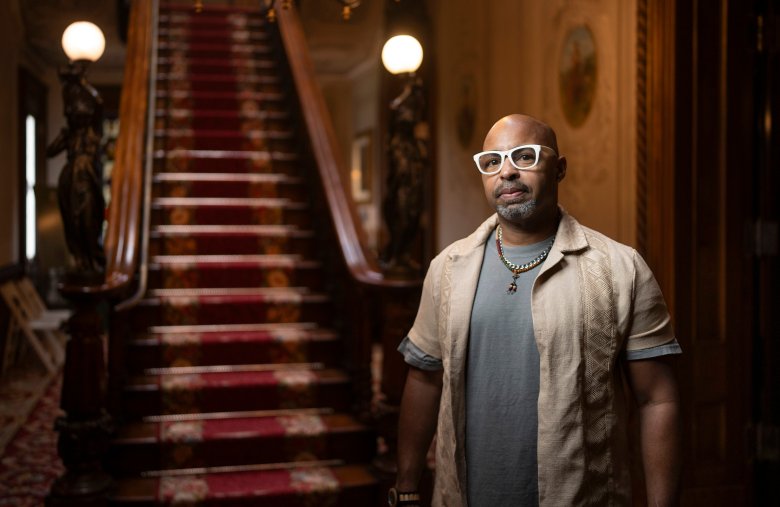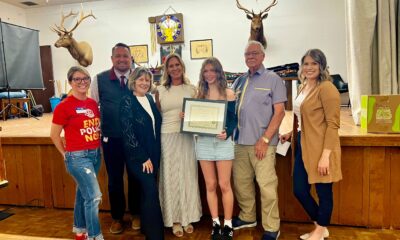Lifestyle
New Orleans Artist Unveils Work Addressing Slavery’s Legacy

A new artwork by New Orleans artist Carl Joe Williams is set to illuminate the complex history of slavery connected to Portland’s Victoria Mansion. His painting, titled “Foundation for the Present, Paid in the Past,” explores the legacy of the Morse family, who constructed the mansion and benefited from slave labor in their New Orleans hotels. The piece will be permanently displayed at the mansion, enriching its narrative and engaging visitors in a deeper understanding of this historical context.
The Victoria Mansion, built between 1858 and 1860, serves as a museum showcasing nearly all of its original furnishings. Recently, the mansion’s staff has made significant efforts to address its ties to slavery, shifting focus from a mere acknowledgment to a thorough exploration of the people enslaved by the Morse family. The mansion’s Executive Director Timothy Brosnihan emphasized the need to tell the stories of those individuals, stating, “This is about people and telling their stories, but the information is fragmentary.”
Uncovering Hidden Histories
During the COVID-19 pandemic, as in-person tours were suspended, the mansion’s staff dove into research that unearthed details about the Morse family’s involvement in slavery. They discovered newspaper archives revealing the family’s social dealings, including slave auctions that were prevalent in New Orleans at that time. In 2021, the mansion initiated the Unwilling Architects Initiative, which aimed to learn more about the enslaved individuals who contributed to the family’s wealth. This project has identified at least 27 individuals who were bought and sold by the Morses, underscoring the impact of this history on the mansion’s legacy.
Through this initiative, the staff created an exhibit in the central stairwell displaying initial findings, including a list of names of the enslaved individuals. This information has also been incorporated into the mansion’s website and visitor pamphlet. Recent discoveries included an advertisement placed by Ruggles Morse in the *Daily Picayune* in 1859, offering a $25 reward for the capture of an escaped waiter named Jo. While there is no record of Jo’s fate, Stacia Hanscom, director of education and public programs, expressed hope that he found freedom.
Art as a Bridge to the Past
To further explore this narrative, the Victoria Mansion received a $3,000 grant from Coffee By Design’s Rebel Blend Fund to commission an original artwork. Indigo Arts Alliance played a crucial role in connecting Williams with the project. Jordia Benjamin, executive director of Indigo Arts Alliance, noted the importance of contemporary art in linking the past to the future, stating, “Artists are leaders in that area and have the gift of being able to visualize and provide a path to those futures.”
Williams, who has experience in various artistic mediums, including painting, murals, and video installations, drew inspiration from the research conducted by the mansion staff. He used his imagination to fill in gaps in the historical record, creating a vibrant painting that contrasts with the sepia-toned images of the past. At the center of the work is the Arcade Hotel, a location where enslaved labor was exploited, surrounded by the faces of those who may have been forced to work there. Williams reflected, “In my work, I tend to honor ancestors. Those people might have been my ancestors in some way, shape, or form.”
The painting is scheduled to be unveiled this spring, marking a significant addition to the mansion’s ongoing efforts to educate visitors about its complex history. According to Brosnihan, “This initiative is a process, and it’s going to unfold into the future, and we’re going to learn more.”
Visitors to the mansion can expect to encounter the painted faces of history, including that of David Wilson, who was emancipated in 1854. Wilson later became a delegate to Louisiana’s constitutional convention and advocated for public education for Black children. His presence in Williams’ artwork transforms him from a mere historical figure into a vivid representation of resilience and hope.
As the Victoria Mansion continues to evolve its narrative, it invites the public to engage with these important stories, reminding all that the legacies of the past remain significant in the present.
-

 Science2 weeks ago
Science2 weeks agoResearchers Challenge 200-Year-Old Physics Principle with Atomic Engines
-

 Politics2 weeks ago
Politics2 weeks agoNHP Foundation Secures Land for 158 Affordable Apartments in Denver
-

 World7 days ago
World7 days agoBoeing’s Aircraft Production: Assessing Numbers and Challenges
-

 Lifestyle5 days ago
Lifestyle5 days agoTrump’s Push to Censor National Parks Faces Growing Backlash
-

 Entertainment6 days ago
Entertainment6 days agoSyracuse Stage Delivers Lively Adaptation of ‘The 39 Steps’
-

 Health2 weeks ago
Health2 weeks agoNeuroscientist Advocates for Flag Football Until Age 14
-

 Lifestyle2 weeks ago
Lifestyle2 weeks agoLongtime Friends Face Heartbreak After Loss and Isolation
-

 Science6 days ago
Science6 days agoAI Misidentifies Doritos Bag as Gun, Triggers Police Response
-

 Lifestyle6 days ago
Lifestyle6 days agoRed Bluff High School’s Elli Nolan Named Rotary Student of the Month
-

 Health2 weeks ago
Health2 weeks agoFDA Launches Fast-Track Review for Nine Innovative Therapies
-

 Politics5 days ago
Politics5 days agoNFL Confirms Star-Studded Halftime Show for Super Bowl LVIII
-

 World2 weeks ago
World2 weeks agoGlobal Military Spending: Air Forces Ranked by Budget and Capability









